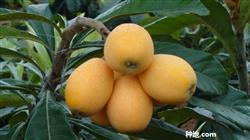How to control diseases and insect pests in loquat trees?

How to control diseases and insect pests by planting loquat? In what season, we should pay more attention to the prevention and control of anthracnose and pear heart borer in loquat planting. 1. Anthrax is mainly harmful to fruits, and leaves and shoots are also seriously damaged in some years. Some years of the disease are very serious, some years are very light. At the beginning of the disease, the fruit is a light brown water-immersed round spot, and then it becomes dark brown round or oval, and the disease part is sunken, forming a concentric wheel-like black spot, which is the conidium disk of the pathogen. When there is Rain Water or moist, the pink slime (that is, conidium) in the conidium disk will overflow. In the later stage, the disease spot expands very quickly, and several disease spots are often combined to form a large disease block, which makes the fruit soft rot or dry shrinkage. The pathogen of anthracnose is a kind of ascomycetes, which overwinters with mycelia on diseased fruit residues and diseased shoots. When it is warm and rainy the following spring, new conidia are produced, and conidia are harmed again with wind, rain and insect transmission. Poor drainage of the garden, dense treetops, too much nitrogen fertilizer, and then encounter continuous rain, seedlings, fruit disease; and in case of wind, hail and other disastrous weather, leaves are prone to disease. The mature stage of late-maturing varieties has entered the plum rain season and the disease is serious. In the prevention and control measures, it is necessary to strengthen the garden ditching and drainage, and the garden should choose a place with higher terrain and can be drained and irrigated. Increase the application of potash fertilizer to enhance the tree potential and improve the ability of disease resistance. Pruning is combined with pruning after harvest to remove diseased fruits and shoots and reduce the source of disease. For seriously ill loquat orchards, 0.3% FUT 0.6% isometric Bordeaux solution or 50% topiramine 500-600 times solution, or 10% should be selected when the fruit changes color. Ether azole (trade name Shigao) 2000-3000 times liquid, or 70% chlorothalonil 300-1000 times solution for control. Second, pear heart borer, also known as pear fruit borer, pear Ji heart borer. There are 5-7 generations in a year. It often harms the grafting interface of young shoots, spikes and seedlings of loquat, and the larvae eat and gnaw and directly cause wilt, indirectly cause germ invasion, and promote the spread of the disease. On the fruit, the adults lay eggs in the calyx tube. After hatching, the larvae decay into the harmful seeds and excrete feces around the seeds, making them inedible. In terms of control, one is to avoid mixed planting of loquat, peach and pear. The second is to kill the larvae and pupae, that is, to trap the trunk bunches of grass or cloth before overwintering, and to remove the bunches of grass and burn them before the overwintering pupae are feathered into adults. Scrape off the old skin and warped skin from the trunk in winter to eliminate overwintering larvae and cocoons. The third is to trap and kill adults. The sweet and sour liquid can be prepared with 1 kg brown sugar, 2 kg rice vinegar and 10-20 kg water to trap and kill adults. 0.1% liter of mercury or several drops of formalin are added to the solution as a preservative. If the tender shoots are found to be eaten and wilted, they should be cut off and burned before they have withered. In addition, 3% acetamiprid 1000-2000 times, 10% imidacloprid 2000-3000 times, 2.5% cyhalothrin 3000 times, 2.5% deltamethrin 2000 times can also be used for drug control. Click to see more loquat planting techniques click to see more fruit planting techniques
- Prev

How to grow loquat with high yield
How to grow loquat with high yield? There are those aspects to pay attention to the cultivation of loquat can refer to the following: loquat is not only rich in nutrition, has a unique taste, but also on the market when the fruit off-season, the market best-selling. Therefore, the cultivation of loquat has good economic benefits. In order to obtain a good harvest of loquat, in addition to selecting improved varieties, we should also pay attention to.
- Next

How can loquat trees be planted with high yield?
How can loquat trees be planted with high yield? How do you manage it? Loquat fruit ripens in early summer, when fruit supply is low. Planting fine varieties of loquat can be put into production in 2-3 years. The fruit yield per mu is about 1500 kg in the peak period, and the income exceeds ten thousand yuan. A, suitable ground seed according to the market demand for seed loquat and...
Related
- Moge, come on! The staff of the peasant association in the producing area of cantaloupe were frightened when the crowd gathered.
- Causes and Solutions of low Fruit setting rate of Apple
- Symptoms and control measures of passion fruit virus disease
- Fruit growing lesson: how do apple orchards keep high yields?
- Can you build orchards in the mountains? What are the pros and cons?
- How to manage the coloring period of Crisson grape?
- This paper introduces the processing technology of two kinds of fig products.
- How much is a month for retired teachers in rural areas by 2020?
- How can strawberry planting increase sugar content? We should pay attention to management in many aspects.
- What are the cultivation techniques on how to improve the yield of golden fruit?

